MALI, THE DOGONS AND TIMBUKTU
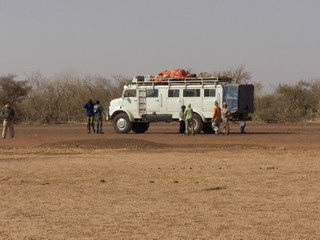 Almost three years ago, when
Marianna Pencharz
asked me to
join her on a trip to Timbuktu,
my response was: “Yes, of course,” pause: “Where exactly is it?” We
have just
returned from that long-planned trip to Mali
and we have a photo by a sign that says “Welcome to Timbuktu.”
See This Week's
Picture
Almost three years ago, when
Marianna Pencharz
asked me to
join her on a trip to Timbuktu,
my response was: “Yes, of course,” pause: “Where exactly is it?” We
have just
returned from that long-planned trip to Mali
and we have a photo by a sign that says “Welcome to Timbuktu.”
See This Week's
Picture
Towards the end of the trip I was overwhelmed by
the
poverty, the dust, the black plastic bags that lay scattered all over
small
hamlets, by visiting a long list of dusty markets and villages, being
the butt of the ever persistent
vendors,
and kids asking for cadeaux. But
distance
gives perspective and I look back and appreciate the interesting places
we
visited. It was a most enjoyable three weeks.
There are over 16 million people living in Mali.
Most live
on a subsistence level, based on agriculture, fishing or herding, cows
or goats.
The
French were there for almost 100 years until independence and their
presence is
still felt in the common usage of French as the lingua franca and the
surprisingly delicious baguettes and flutes. The distances between
places are far
and dusty over dirt tracks or piste. Our group of 9 traveled by
minivan, jeep,
and desert truck as well as 3 glorious days sailing on a pinasse on the
Niger River.
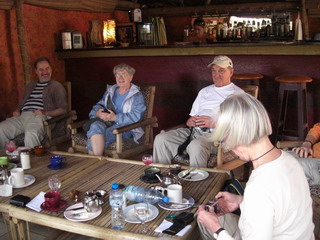 Our party gathered at Bamako
where we were introduced. Ian, Janet and Jim relax after
at the
briefing.
Our party gathered at Bamako
where we were introduced. Ian, Janet and Jim relax after
at the
briefing.
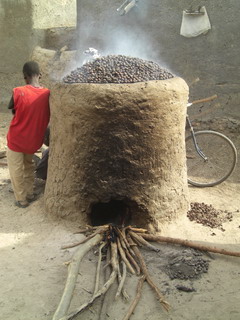

Making our way north we stopped at a Bambara village to
see how
they make Shea butter or karite. The nuts ripen at the same
time as millet
and sorghum – the main grains of Mali. The women dig a hole
and
place the nuts inside. In late January during the dry season,
when there
is not so much to do, the women take out the nuts and roast them, crack
the
shells and then pound, cook and purify the meat inside. The resulting
shea
butter is formed into large slabs. The family sets aside what they need
for
cooking and other household uses and then sells the rest at markets in
spiked
balls of shea butter. It is the main oil
for cooking and especially useful as it doesn’t need refrigeration.
Baobab trees dot the landscape. The trunks are
stripped of the bark to make ropes. The branches
support woven
bee hives. Mali
honey is dark and delicious, almost like maple syrup
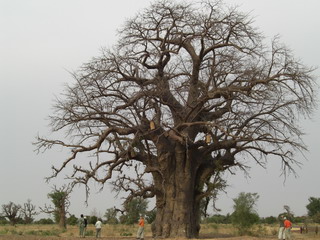
A calabash field. The
calabashes will be sold as
containers
and as units of measure – most places sell dry goods by volume.
We overnighted at Djenne to see the famous Monday
market and
mud mosques. The ancient mosque with 100 pillars and numerous towers is
made
from special deep mud by master masons. The wooden poles are for
decoration but
also act as scaffolding when the mud plaster is renewed annually by the
people.
This is a UNESCO World Heritage site and many buildings have been
restored by
the organization.

Monday
market
Marlene
with our favorite vendor
We saw French schools and madrasas where secular
studies like math, geography, French etc
are
taught. Poor parents from outlying areas send their children to towns
to study the Koran. The students prepare
a wooden board covered with fine mud
and then copy a sura from the Koran onto it. After learning it by rote
(and not
understanding the meaning, we were told) they are tested. Afterwards
they re-cover
the board and then copy out the next passage. Only as adults will they
learn the meaning of what they studied.
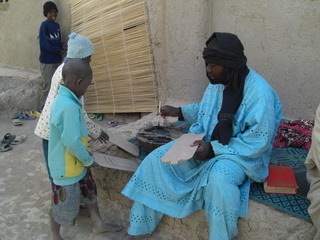
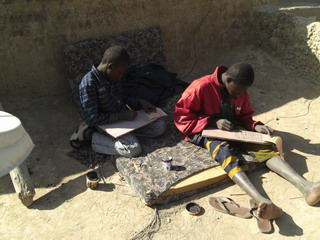
This picture taken in Timbuktu is of
Talibe, young children who
literally live and learn on the streets. They have no formal education,
unlike
the children who learn in Madrasas. They walk
around
with little buckets that the local population (and us tourists) are
expected to
fill with
food for them and their teacher.
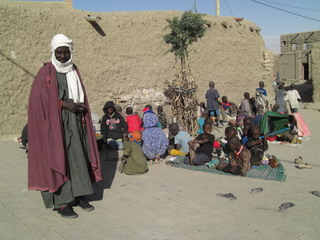
<>
Our next main stop was on the Bandiagara
escarpment. We
stayed at the delightful La Falaise, with its attractive courtyard
and great gingembre
or ginger beer. We ate a lot of couscous and rice during our trip
as well as stringy chicken and delicious kapitaine or Nile Perch. We
also tasted mutton in peanut sauce and yam. The food was generally
good but surprisingl;y expensive, like everything else in Mali.
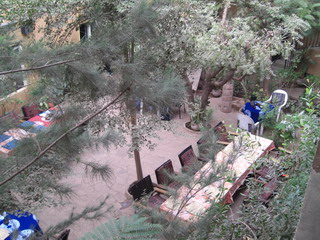
The escarpment, better known as pays Dogon, is
home to
many animists. Although 90% of the population claims to be Moslem,
animism has
strong roots in these outlying villages. The village houses, like most
of the
rest of Mali
are made from mud. We visited Songho village. Families live in
compounds with a
sleeping area, a room for each wife and a toilet. In addition there are
a
number of thatched granaries, either to store millet or female
granaries which
act as a treasure kist for the wives. A powerful and rich leader
decorates his granary with animal skins, a Dogon ladder and millet
sticks. What appears to be a window is actually the only entrance
to the granary.
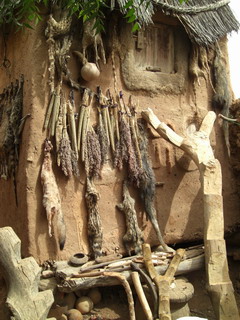
On the ridge above the village there is a
circumcision
ceremony every three years for boys aged 10-13. They remain secluded
for a
month and learn adult secrets. They then have a race. The winner is
given a
granary of millet, the 2nd is promised the most beautiful
girl, and
the 3rd gets cattle and goats.
Ancient Teli houses above the newer
Dogon houses.
Today the village is in the valley below but the ancient buildings are
still used
for storage, burial and ritual.
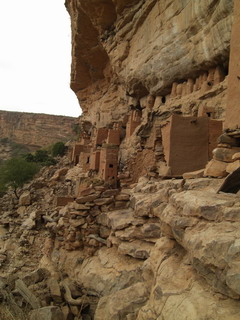
 Modern Songho village
Modern Songho village
 During
the month of healing the boys are instructed in how to be a man and how
to behave. Circumcised boys don’t draw new paintings but repaint
ancient ones. Our local guide told us that young girls are also
circumcised.
During
the month of healing the boys are instructed in how to be a man and how
to behave. Circumcised boys don’t draw new paintings but repaint
ancient ones. Our local guide told us that young girls are also
circumcised.
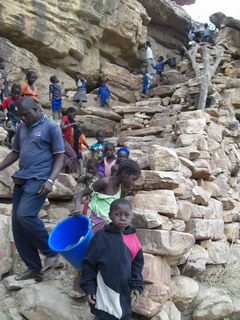 We also visited Neogora a very
secluded hillside
village.
The steps are the only way into the village. Everything has to brought
up into the village via these steps.
We also visited Neogora a very
secluded hillside
village.
The steps are the only way into the village. Everything has to brought
up into the village via these steps.
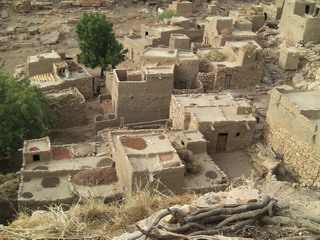 The roofs are used for drying
hibiscus leaves for
tea,
peppers and calabashes
The roofs are used for drying
hibiscus leaves for
tea,
peppers and calabashes
The tour was quite tiring. Here most of our group
gets a
welcome afternoon nap before the masked dancing at Emde. The masked
dances were extremely powerful; they describe the world and have a
strong ritual element. Even today
children
are not allowed near the dancers lest they identify the dancers.
We met a Dogon priest Rojokuma who practises fox
divination. In the late afternoon people come
and ask
him questions. He places sticks and stones in a certain order and
scatters
peanuts within the squares. At night the jackals come to eat the
peanuts. According to
their foot
prints he is able to divine the future and the correct answer.
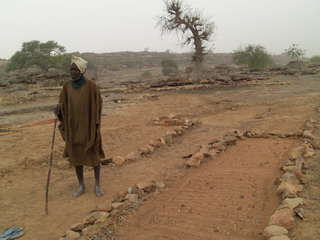
Mopti is one of the main ports. We saw salt slabs
from the
salt mines in the north, brought to Timbuktu
by large camel caravans. Each camel carries 2 slabs on either side.
From Timbuktu the salt is taken by boat along the river.

Everywhere we saw and smelled smoked and dried
fish. The main
fish is
tilapia, but also little catfish. The fish were so small; I fear it
points to overfishing. The Bozo people are nomadic fisherman. In the
dry season when the rivers shrink, they follow the fish and live in
temporary huts along the banks of the Niger river.
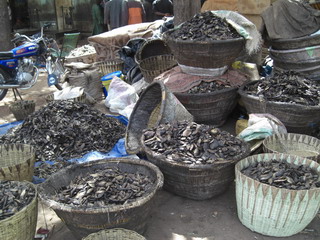
We also saw many onion fields,
part of a US Aid project. Mali
exports
onions, both fresh and dried. Onions formed the basis of many delicious
sauces. Along the river banks we saw people watering the onions by pump
but also by calabash. All villages have wells and it is hard work
drawing water. Some villages did have hand pumps. In the towns well
water is free but there is a charge for drinking water from special
pumps.
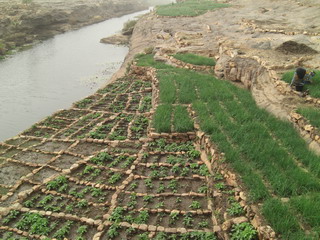
At the boat yard in
Mopti we saw how the men shape
mahogany planks
to make their boats and also how they make nails from the bodies of old
cars. Note bicycle wheel bellows.
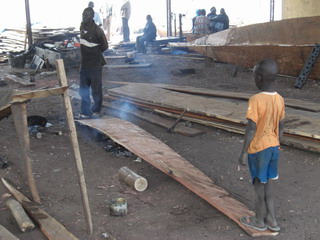

er.
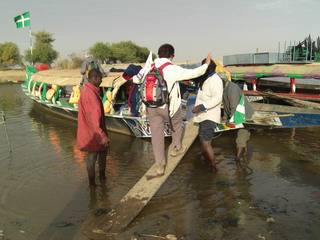 We
made our way to Timbuktu
via pinasse. It was wonderful to see life on and along the Niger River
at eye level. The River has its own rhythm and our captain kept a sharp
eye out for shallow banks and often poled to gauge the depth.
We
made our way to Timbuktu
via pinasse. It was wonderful to see life on and along the Niger River
at eye level. The River has its own rhythm and our captain kept a sharp
eye out for shallow banks and often poled to gauge the depth.
 A
pinasse ferrying people and goods
A
pinasse ferrying people and goods
Camping on the banks of the Niger
River
Hippos near the river bank
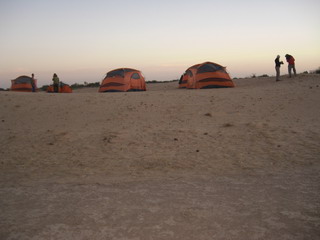
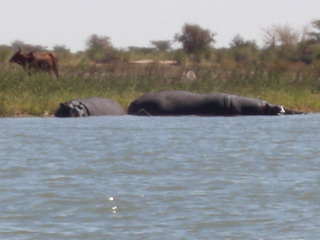
Reaching Timbuktu
our group and Ya-ya our guide take a group photograph.
The people on tour were very widely traveled.
Mali
does not top most people’s ‘must do’ list. The group hailed from
England, USA, and Canada. All had lived outside their
own
countries, working in Africa, Australia
and the Arctic but particularly in
Arab
countries. It was a pleasure to share this adventure with such nice
people.
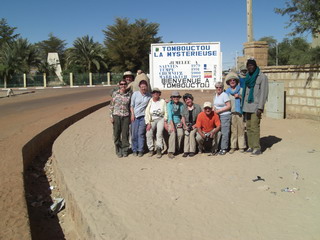
Timbuktu’s
glory is in its mystique and fabulous past. It was a strategic point on
the trans-Sahara caravan route, where salt, gold,
ivory,
and slaves were traded; as well as an important center for Islamic
learning. We
collected as many Timbuktu
stamps on our
passports as we could, including from the police and the post office. Even today Timbuktu is on the edge of the
Sahara desert and 9 hours by dirt road from the nearest major
town. While some rode a camel a few of us walked the dunes to a Tuareg
temporary dwelling to enjoy Tuareg tea. It includes an elaborate
ceremony of pouring tea from cup to cup and tea pot until it is
foaming. Visitors are expected to have 3 cups of tea - one for life,
the second for death and the third for love.
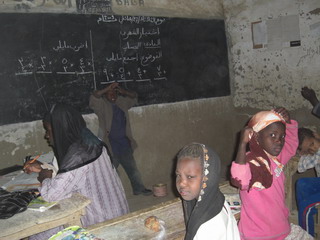 Children learning at a Madrasa
in Timbuktu
Children learning at a Madrasa
in Timbuktu
The sign at the house where Rene Caillie lived in
1828. He was
the first
foreigner to reach Timbuktu
and return alive. He learnt Arabic and Islam, posing as a devout Muslim
<>
After a long and very dusty ride by desert truck
we reached
Segou where we attended the Festival on the Niger.
The music festival had 2 parts, the day
performances which
were free and the evening performances which charged an entrance fee –
a hefty
100 euro for visitors. We especially enjoyed the day activities with
performances
from Mali, Ghana, Burkina
Faso, Portugal,
Germany, and Mexico.
There
were troupes of dancers, all dressed up who came and danced if they
liked the
music. People in the audience would be overcome, get up and dance and
then go
and sit again. Everybody was there - dignitaries, tourists, locals from
all over as well as the ubiquitous vendors who followed us from place
to place. It was great fun.
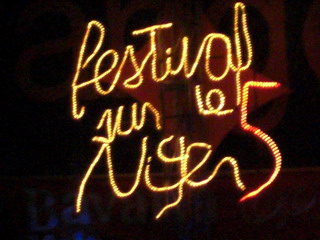

Segou still boasts
faded French Colonial
buildings. At the
municipality we join the staff in some Malian dancing
Marianna and Nora
admire mud cloth materials drying on the sand as part of the dying
process. The
spinning
is done by women but men weave the cloth in narrow dtrips and then
paint them.
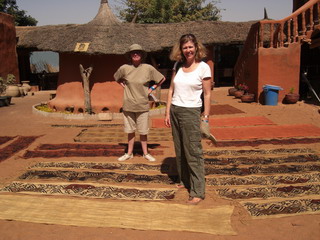
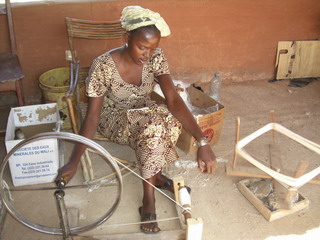
 Marianna, me, Marlene, Willi
and Nora wait for our
ginger
beer or hibiscus tea on a porch above the artisans workshop..
Marianna, me, Marlene, Willi
and Nora wait for our
ginger
beer or hibiscus tea on a porch above the artisans workshop..
We returned to Bamako
where
the group split up, going home to England,
Canada, the States
and Willi
continuing to Morocco.
We look forward to Willi's DVD and Jim's photos.
On the last day in Mali I met up with Sheila
Goldberg, a friend from Israel.
We spent the day at the fascinating Maison des Artisans and the
Fetish
market. Sheila enjoys a welcome pineapple drink. We enjoyed a last
kapitaine fish dinner at the Pirate with Marlene and Willi. The next
morning Sheila and I flew to Addis Ababa
where we
overnighted before we returned to Israel.
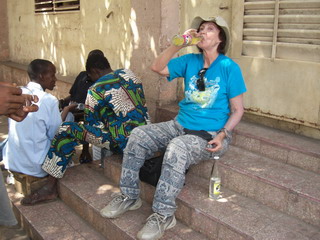
Although Mali does not offer exciting scenery it
has many fascinating aspects. We saw a very poor African country where
life is hard and daily existence is all consuming. We saw grandiose
schemes that petered out and also attempts at grass roots projects
which would seem to offer a chance for a better future. Although
Moslem, it is a very mild form of Islam and when people found out I was
from Israel I was always
welcomed.
Should anybody require a guide in Mali, I highly recommend our guide,
Yaya Keita. He is fluent in both French and English as well as in local
dialects. He
is well organized and knowledgeable and was always concerned about our
welfare and safety - even when he was suffering from a bout of malaria!
He may be contacted either at +223-(7)
6106009 or via e-mail
bf07ykyaya@yahoo.fr
Go
to the top of this page
Almost three years ago, when
Marianna Pencharz
asked me to
join her on a trip to
 Our party gathered at Bamako
where we were introduced. Ian, Janet and Jim relax after
at the
briefing.
Our party gathered at Bamako
where we were introduced. Ian, Janet and Jim relax after
at the
briefing.Modern Songho village
We also visited Neogora a very
secluded hillside
village.
The steps are the only way into the village. Everything has to brought
up into the village via these steps.
The roofs are used for drying
hibiscus leaves for
tea,
peppers and calabashes
Children learning at a Madrasa
in Timbuktu
Marianna, me, Marlene, Willi
and Nora wait for our
ginger
beer or hibiscus tea on a porch above the artisans workshop..